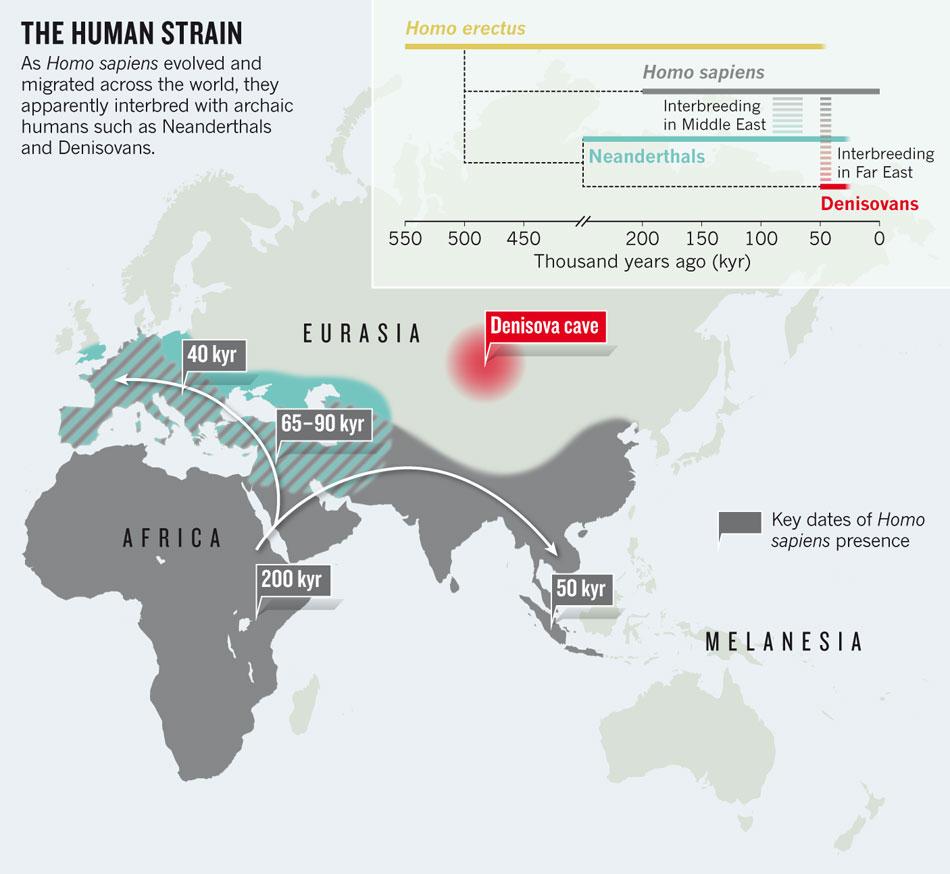In 2008, a fossil tooth and finger bone were found in a cave in Siberia. After analysis it turned out to belong to a new species of human, now known as the Denisovans. In 2010, a draft of the Neanderthal genome was released, providing indications for potential interbreeding with our ancestors. In the same year, analysis of the Denisovan genome also revealed indications for potential interbreeding.
Now, a new study, published in Science, states that these interbreeding events could have boosted the human immune system.
Modern humans, Neanderthals and Denisovans all share a common ancestor in Africa (see figure 1). This populations split up about 400,000 years ago in distinct groups. One went northwest, giving rise to the Neanderthal lineage, another one went northeast, forming the root of the Denisovan lineage, and the third one stayed in Africa. For a while, at least. Several hundreds of thousands of years later, the African population expanded into Eurasia, meeting their evolutionary cousins (see figure 2).

Figure 1: Potential evolutionary tree of modern humans, Neanderthals and Denisovans.
(Source: The New York Times)

Figure 2: When modern humans left Africa, they met their cousins,and possibly interbred with them.
(Source: Callaway, E. (2011). Ancient DNA reveals secrets of human history. Nature.476, pp. 136 - 137. doi:10.1038/476136a. Click here to read it.)
Studies have shown that about 4% of Neanderthal DNA might have found its way into the genome of modern man. For the Denisovans, this could be 6%. This interbreeding might’ve had a positive impact on human fitness. New variants of immune system genes, called the HLA class I genes, were introduced. These genes are some of the most variable and adaptable in our genome, partly because the rapid evolution of viruses requires flexibility in the immune system.
One HLA variant, HLA-B*73, is rare in present-day African populations, but occurs in higher frequency in West Asian populations. The likely source of this gene type, according to the paper, are the Denisovans. The same holds true for another variant, HLA-A*11, absent in African populations, but very frequent in East Asia and Oceania. Other variants are common in European and Asian populations, but absent in African populations, and supposedly find their origin in Neanderthal DNA.
In the words of the authors:
Virtual genotyping of Denisovan and Neanderthal genomes identified archaic HLA haplotypes carrying functionally distinctive alleles that have introgressed into modern Eurasian and Oceanian populations. … Thus, adaptive introgression of archaic alleles has significantly shaped modern human immune systems.
For some comments on the paper, be sure to check this post on the Discover Magazine blog Not Exactly Rocket Science.
In short:
- The absence, or rather rarity, in Africa of certain variants could be explained alternatively by, for example, a small disadvantage against malaria.
- The presence of A*11 in Denisovans and modern Asians could be explained through coincidence. To truly prove that modern Asians acquired this variant from Denisovans, derived mutations that are common to these groups, but absent elsewhere, would have to be found.
- The B*73 variant could have come from Neanderthals, as Denisovan genes are hard to find outside southeast Asia and Melanesia.
So, further research is needed to confirm this interesting hypothesis.
Reference
Abi-Rached, L.; Jobin, M.J.; Kulkarni, S.; McWhinnie, A.; Dalva, K.; Gragert, L.; Babrzadeh, F.; Gharizadeh, B.; Luo, M.; Plummer, F.A.; Kimani, J.; Carrington,M.; Middleton, D.; Rajalingam, R.; Beksac, M.; Marsh, S.G.E.; Maiers, M.; Guethlein,L.A.; Tavoularis, S.; Little, A.-M.; Green, R.E.; Norman, P.J. and Parham, P.(2011). The Shaping of Modern Human Immune Systems by Multiregional Admixture with Archaic Humans. Science. Published online, August 25. Doi:10.1126/science.1209202.
Stanford University Medical Center, News.



Comments